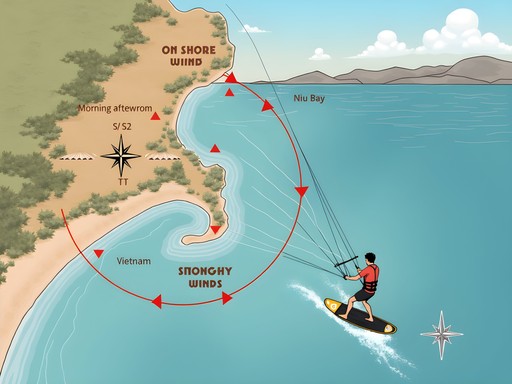Disclosure: This article contains affiliate links. We may earn a commission from purchases at no extra cost to you, which helps our travel content.
Well, mates, I never thought I'd be comparing the deserts of Vietnam to the rainy streets of Liverpool, but life takes you on strange routes sometimes. After 35 years behind the wheel of buses across two continents, I've seen my fair share of landscapes through windscreens, but nothing quite prepared me for the otherworldly sight of Mui Ne's Red Sand Dunes. These magnificent rust-colored mounds rising from the Vietnamese countryside look like they've been nicked straight from Mars and plonked down in Southeast Asia. When my old mate Geoff suggested we add this detour to our Vietnam adventure, I nearly scoffed at the idea. A desert? In Vietnam? Pull the other one. But blow me down if it wasn't one of the most spectacular sights these tired bus driver eyes have ever witnessed. So grab a brew, settle in, and let me share everything you need to know about tackling these magnificent dunes without breaking the bank or your back.
Getting to Mui Ne's Red Sand Dunes: A Transport Man's Guide
If there's one thing a retired bus driver knows, it's how to navigate public transport in foreign lands. Getting to Mui Ne from Ho Chi Minh City is straightforward enough – you've got options that won't savage your wallet.
The sleeper buses are your best bet for value, running about 200,000-250,000 VND (roughly £7-9). As someone who's spent half his life navigating Liverpool's roundabouts in a double-decker, I can tell you these Vietnamese bus drivers earn every penny. The overnight journey takes about 5-6 hours depending on traffic, and while the 'sleeper' seats aren't exactly the Ritz (especially if you're a stocky 5'10" like yours truly), they're leagues better than sitting upright.
Once you're in Mui Ne proper, you'll need to get to the dunes themselves. Now, this is where it gets interesting. Most tourists get fleeced taking expensive tours, but here's my transport insider tip: arrange a motorbike taxi (xe ôm) for about 150,000 VND (£5) round trip. The driver will wait while you explore. If you're comfortable on two wheels, hiring your own motorbike runs about 100,000-150,000 VND (£3.50-5) per day. Just remember to bring your international driving permit – something I learned the hard way after a rather awkward encounter with local police.
The Red Dunes are about 10km northeast of Mui Ne's main strip. Unlike the touristy White Dunes further north, these beauties are easier to access and less crowded – perfect for us independent travelers who prefer to avoid the package holiday crowds.

💡 Pro Tips
- Ask your accommodation to arrange a reliable xe ôm driver to avoid inflated tourist prices
- If hiring a motorbike, photograph any existing damage before riding off
- Visit early morning (5-7am) or late afternoon (4-6pm) to avoid midday heat and crowds
Sandboarding: An Old Bus Driver's New Trick
At 64, with knees that have seen better days after decades of clutch work, I wasn't exactly planning on throwing myself down sand mountains on a plastic board. But as we Scousers say, 'in for a penny, in for a pound.'
As soon as you arrive at the dunes, you'll be approached by local kids offering plastic sleds for rent – usually around 20,000 VND (less than £1). These simple contraptions look like they've been fashioned from cut-up jerry cans, and frankly, they have. Don't expect professional snowboarding equipment here.
My first attempt was what you might politely call 'ungraceful' – picture a stocky bus driver tumbling head over heels down a sand dune while a group of Vietnamese children howl with laughter. By the third go, though, I'd figured out the basics: sit on the sled, lean back slightly, lift your feet, and let gravity do the work.
If you're after a smoother ride, I'd recommend bringing your own microfiber towel to sit on. These pack down small in your daypack and create less friction than the plastic sleds. Plus, they're handy for wiping off the inevitable sand that will find its way into every crease of your body.
For those with dodgy knees like mine, there's no shame in being a spectator. The youngsters put on quite the show, and watching the sunset paint the dunes in fiery oranges and reds while sipping a cold Tiger beer is a perfectly respectable alternative.

💡 Pro Tips
- Wear shorts or trousers you don't mind getting sandy – the red sand stains light-colored clothing
- Empty your pockets before sliding – phones and sand don't mix
- Negotiate the sled rental price before accepting – 20,000 VND is standard
Desert Photography: Capturing the Magic Without Fancy Gear
When my wife gifted me that Canon camera for my 55th birthday, I hadn't the foggiest idea I'd end up photographing desert landscapes in Vietnam. Yet here we are.
The Red Dunes are a photographer's dream, even for an amateur like me. The rippled patterns in the sand, the play of light and shadow, and the stark contrast between the rusty red sand and blue sky create postcard-perfect shots without much effort.
My top recommendation is timing. The early morning light (5:30-7:30am) creates dramatic shadows across the dunes, while the 'golden hour' before sunset (around 4:30-6pm) bathes everything in warm amber light that makes the red sand positively glow. Mid-day sun washes out the colors and makes the heat unbearable – trust a man who's driven un-air-conditioned buses in Sydney summers.
You don't need professional gear either. My trusty mid-range camera does the job nicely, though I've added a polarizing filter which helps manage glare and makes the sky pop against the sand. Even a decent smartphone will capture stunning images, especially newer models with wide-angle lenses.
For composition, look for natural leading lines in the sand ripples. Include a person (or yourself) in some shots to provide scale – these dunes are more massive than they appear in photos without reference points. And don't forget to protect your gear from the sand! I learned this lesson when I had to spend an hour cleaning fine red dust from my camera after a particularly enthusiastic tumble down a dune.

💡 Pro Tips
- Bring a small brush to clean sand from your camera or phone
- Use burst mode to capture action shots of sandboarding
- Look for footprint-free areas for pristine sand ripple photos
Local Culture & Etiquette: A Working-Class Perspective
One thing my years of driving buses taught me is that you meet all sorts in public transport. From suited businessmen to school kids to late-night revelers who've had a few too many, I've seen humanity in all its forms. This experience has given me a knack for reading local customs and respecting different ways of life.
The Red Dunes area is home to fishing communities who've seen their quiet corner of Vietnam transform into a tourist hotspot. While tourism brings money, it also brings challenges. The local kids selling sleds and offering to guide you are trying to make a living, but some tourists treat them poorly or try to haggle them down to nothing.
My approach? Respect goes both ways. I'm happy to pay a fair price (not the inflated tourist rate, mind you) for services, and I expect fair treatment in return. A bit of basic Vietnamese goes a long way – 'xin chào' (hello) and 'cảm ơn' (thank you) open doors that remain closed to those who expect everyone to speak English.
Some tourists treat the dunes like a private playground, leaving rubbish behind. As someone who's spent countless hours cleaning gum from bus seats, this behavior makes my blood boil. The simple rule my mum taught me still applies: leave a place better than you found it.
And while we're on the topic of respect, remember that revealing clothing might be fine on Western beaches but can cause discomfort in more conservative areas. I'm not saying dress like you're going to church, but a bit of modesty goes a long way, especially when you're off the main tourist drag.

💡 Pro Tips
- Learn a few basic Vietnamese phrases – locals appreciate the effort
- Bring a small bag to carry out your trash and maybe pick up a bit more
- Ask before photographing local people, especially children
Budget Accommodation & Food Near the Dunes
As someone who's lived on a bus driver's salary most of my life, I've become something of an expert at finding value without sacrificing comfort. Mui Ne offers options for every budget, but I'll focus on what I know best – getting a decent night's sleep and a good feed without emptying your wallet.
For accommodation, the main strip of Mui Ne has plenty of guesthouses and budget hotels ranging from 250,000-500,000 VND (£9-17) per night. I stayed at a family-run place called Hong Di Guesthouse about 3km from the dunes, which set me back 300,000 VND (about £10) for a clean room with air conditioning and hot water. Nothing fancy, but everything worked, and the family treated me like one of their own.
If you're after something with a bit more character, consider the hammock option. Several beachside cafes allow you to hang a hammock for a minimal fee or the price of a few drinks. I spent one glorious night swaying in the sea breeze after a day at the dunes – though at my age, I was grateful for my proper bed the next night!
For food, skip the tourist traps and head where the locals eat. The seafood in Mui Ne is spectacular and surprisingly affordable if you venture away from the main drag. My top pick was a little place called Lâm Tòng, where a feast of fresh crab, prawns, and morning glory vegetable stir-fry with rice cost less than 200,000 VND (£7). Wash it down with local beer for 15,000 VND (50p) a bottle.
For quick meals, the bánh mì sandwich stalls offer delicious filled baguettes for about 20,000-30,000 VND (less than £1). Perfect for packing before heading to the dunes for sunrise.

💡 Pro Tips
- Book accommodation directly rather than through online platforms for better rates
- Eat dinner around 6-7pm when seafood is freshest and restaurants less crowded
- Carry small bills for street food purchases
Final Thoughts
As I stood atop the highest dune watching the sun sink below the horizon, painting the sand in shades of crimson and gold, I couldn't help but chuckle at life's strange turns. From navigating Liverpool's congested streets to sliding down Vietnam's red sand mountains – not the retirement most bus drivers envision! But that's the beauty of travel, isn't it? It shows you possibilities you never imagined existed.
Mui Ne's Red Sand Dunes might not have the fame of the Sahara or Dubai's deserts, but their accessibility, affordability, and sheer beauty make them a must-visit for anyone in Vietnam with a weekend to spare and a sense of adventure. Whether you're young enough to throw yourself headlong down dunes or old enough to prefer photographing others doing so, these magnificent formations offer something for everyone.
So pack light, bring plenty of water, and prepare to get sand in places you didn't know you had. The Red Dunes of Mui Ne are waiting to show you that Vietnam is far more than just rice paddies and beaches – and this old bus driver guarantees it'll be a ride to remember.
✨ Key Takeaways
- Visit early morning or late afternoon for the best light and comfortable temperatures
- Skip expensive tours and arrange your own transport for significant savings
- Respect local communities and environment by minimizing your impact
- You're never too old to try sandboarding – just be prepared to laugh at yourself
📋 Practical Information
Best Time to Visit
November to April (dry season)
Budget Estimate
£30-50 per day including accommodation, food, and activities
Recommended Duration
1-2 days
Difficulty Level
Moderate (Walking In Sand Requires Effort)
















Comments
Claire Hawkins
Hunter, your bus driver perspective made me smile! We took our family to Mui Ne last winter and your guide was spot on. The kids went absolutely wild sandboarding down those red dunes! One tip for families I'd add - bring old clothes you don't mind getting stained. That red sand does NOT come out easily (my daughter's white shirt is now permanently pink-ish). We caught sunrise instead of sunset to avoid crowds, and it was magical watching the kids' silhouettes against the dawn sky. Your working-class perspective on interacting with locals was refreshing too - we followed your advice on fair tipping and had such genuine interactions. Looking forward to more of your unique travel takes!
Hunter Bernard
Cheers Claire! Sunrise is a top tip - less people and cooler temps. Glad the family enjoyed it. Those pink shirts become souvenirs in their own right, don't they? 😂
wildmate
How's the crowd situation? Best to avoid weekends?
citystar
Those sunset photos are incredible! Did you use any special settings? I'm heading there next month and I'm still learning photography basics.
Hunter Bernard
Thanks mate! Nothing fancy - just the golden hour magic. Try getting there about 45 mins before sunset and play with silhouettes. A bus driver's hands aren't made for fancy camera work, but even I managed decent shots!
happystar
Planning to visit in January - is that a good time? Also, how much should we expect to pay for the plastic sleds?
Claire Hawkins
January is perfect! We went last January with our kids and the weather was lovely - warm but not scorching. For the sleds, we paid about 40,000 VND per sled after some friendly haggling. My 7-year-old actually got better at sandboarding than her dad! Bring a scarf to cover your face from blowing sand and don't forget water!
happystar
Thanks Claire! That's super helpful. Did you get a guide or just went on your own?
Claire Hawkins
We just went on our own! It's easy to find and navigate. Used my compact binoculars to spot some cool birds on the way too!
redace
Just got back from Mui Ne last week and those red dunes are something else! Did the sandboarding thing and ended up with sand in places I didn't know existed. Hunter's tip about going early morning saved us from that midday heat - absolute lifesaver. The locals renting plastic sleds tried charging us double at first, but we negotiated down like the post suggested. Still have sand in my camera bag though!
happystar
Did you try the white dunes too? Worth it?
redace
Yeah, did both! White dunes are bigger but red ones have better colors for photos. Do both if you can!
wildguide
Just got back from Mui Ne and followed your guide - it was SPOT ON! We went for sunset like you suggested and WOW those colors were incredible! We rented the plastic sleds from local kids (haggled down to 40,000 dong for an hour) and had a blast sliding down. The climb back up nearly killed me though! 😂 One tip for others: bring water shoes if you have them. The sand gets CRAZY hot even in the evening!
dreamguide
Thanks for the water shoes tip! Would you say it's worth spending a full day in Mui Ne or is half a day enough for the dunes?
wildguide
We did a full day - Red Dunes for sunset, White Dunes for sunrise the next day, then spent some time at the Fairy Stream and fishing village. Definitely worth a full day if you can spare it!
Douglas Bradley
Hunter, your post brought back so many memories! I visited Mui Ne last year and was equally impressed by those stunning red dunes. One thing I'd add for readers - the White Sand Dunes about 45 minutes away are also worth visiting if you have time. They're less crowded and offer a completely different landscape. For photography enthusiasts, I found that a polarizing filter made a huge difference with the harsh desert light. My travel tripod was essential for those sunset shots when the light was changing rapidly. Your section on local etiquette was spot on - those kids offering to 'help' with sandboarding definitely expect payment, and negotiating upfront is the way to go. Great guide overall!
wildguide
The White Dunes are AMAZING! We actually liked them better than the Red Dunes. Less touristy for sure.
sunsetphotographer
Those sunset shots are incredible! What camera settings did you use for the dune silhouettes?
dreamguide
Thanks for this guide, Hunter! I'm heading to Vietnam next month and just added Mui Ne to my itinerary after reading this. As a fellow Brit (Manchester here), I appreciate your working-class perspective. Did you find the local buses reliable enough or would you recommend splurging on private transport? Also, how physically demanding is the sandboarding? I've got dodgy knees but still want to give it a go!
wildguide
Not the author but I was just there last week! The local buses are totally fine if you're not in a rush. And for sandboarding, it's mostly just climbing up the dunes that's hard on the knees. Going down is easy peasy!
dreamguide
Thanks mate! That's really helpful. Did you go early morning or sunset?
wildguide
Definitely sunset! The light was amazing for photos and it wasn't as hot. Just be prepared for lots of other tourists with the same idea!
exploreone
Just got back from Mui Ne and followed your photography tips! Got some killer shots even with my basic phone camera. That golden hour light is everything! Thanks Hunter!
Venture X
Premium card with 2X miles, $300 travel credit, Priority Pass